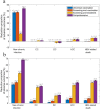Impact and Cost-Effectiveness of Biomedical Interventions on Adult Hepatitis B Elimination in China: A Mathematical Modelling Study
- PMID: 37349664
- PMCID: PMC10469118
- DOI: 10.1007/s44197-023-00132-1
Impact and Cost-Effectiveness of Biomedical Interventions on Adult Hepatitis B Elimination in China: A Mathematical Modelling Study
Abstract
Background: China has one of the highest hepatitis B virus (HBV) disease burdens worldwide and tracking progress toward the 2030 HBV elimination targets is essential. This study aimed to assess the impact of biomedical interventions (i.e., adult vaccination, screening and treatment) on the adult HBV epidemic, estimate the time for HBV elimination, and evaluate the cost-effectiveness of the interventions in China.
Methods: A deterministic compartmental model was developed to project the HBV epidemic from 2022 to 2050 and estimate the time to meet elimination targets under four intervention scenarios. Cost-effectiveness was calculated using incremental cost per quality-adjusted life year (QALY) gained, i.e., average cost-effectiveness ratio (CER).
Results: Under the status quo, there will be 42.09-45.42 million adults living with HBV in 2050 and 11.04-14.36 million HBV-related deaths cumulatively from 2022 to 2050. Universal vaccination would cumulatively avert 3.44-3.95 million new cases at a cost of US$1027-1261/QALY gained. The comprehensive strategy would cumulatively avert 4.67-5.24 million new chronic cases and 1.39-1.85 million deaths, expediting the realization of the elimination targets forward to 2049. This strategy was also cost-effective with an average CER of US$20,796-26,685/QALY and a saved healthcare cost of US$16.10-26.84 per person.
Conclusion: China is not on track to meet the elimination targets but comprehensive biomedical interventions can accelerate the realization of the targets. A comprehensive strategy is cost-effective and cost-saving, which should be promoted in primary care infrastructures. Universal adult vaccination may be appropriate in the near future considering practical feasibility.
Keywords: Cost-effectiveness; Elimination; Hepatitis B; Intervention; Mathematical modeling.
© 2023. The Author(s).
Conflict of interest statement
The authors declare that they have no conflicts of interest. The funders had no role in the design of the study; in the collection, analyses, or interpretation of data; in the writing of the manuscript, or in the decision to publish the results.
Figures




Similar articles
-
Impact of the national hepatitis B immunization program in China: a modeling study.Infect Dis Poverty. 2022 Oct 11;11(1):106. doi: 10.1186/s40249-022-01032-5. Infect Dis Poverty. 2022. PMID: 36221140 Free PMC article.
-
Cost-effectiveness of universal screening for chronic hepatitis B virus infection in China: an economic evaluation.Lancet Glob Health. 2022 Feb;10(2):e278-e287. doi: 10.1016/S2214-109X(21)00517-9. Lancet Glob Health. 2022. PMID: 35063115 Free PMC article.
-
The cost-effectiveness of universal hepatitis B screening for reaching WHO diagnosis targets in Australia by 2030.Med J Aust. 2023 Mar 6;218(4):168-173. doi: 10.5694/mja2.51825. Epub 2023 Jan 3. Med J Aust. 2023. PMID: 36596568
-
A global investment case for hepatitis B elimination: a modelling study.Lancet Gastroenterol Hepatol. 2023 Oct;8(10):932-942. doi: 10.1016/S2468-1253(23)00156-5. Epub 2023 Jul 27. Lancet Gastroenterol Hepatol. 2023. PMID: 37517417 Review.
-
Prophylaxis of cervical cancer and related cervical disease: a review of the cost-effectiveness of vaccination against oncogenic HPV types.J Manag Care Pharm. 2010 Apr;16(3):217-30. doi: 10.18553/jmcp.2010.16.3.217. J Manag Care Pharm. 2010. PMID: 20331326 Free PMC article. Review.
Cited by
-
Assessing the impact of comorbid type 2 diabetes mellitus on the disease burden of chronic hepatitis B virus infection and its complications in China from 2006 to 2030: a modeling study.Glob Health Res Policy. 2024 Jan 22;9(1):5. doi: 10.1186/s41256-024-00345-2. Glob Health Res Policy. 2024. PMID: 38246986 Free PMC article.
-
Effectiveness of catch-up vaccination from 2009 to 2011 on incidence of hepatitis B in Guangzhou, China: a time series analysis.BMC Public Health. 2025 Apr 25;25(1):1551. doi: 10.1186/s12889-025-22437-5. BMC Public Health. 2025. PMID: 40281566 Free PMC article.
References
-
- WHO. Hepatitis B. 2021. https://www.who.int/news-room/fact-sheets/detail/hepatitis-b. Accessed 1 Aug 2022.
-
- WHO. Global Hepatitis Report 2017. https://www.who.int/publications/i/item/9789241565455. Accessed 1 Aug 2022.
-
- WHO. Global health sector strategy on viral hepatitis 2016-2021: Towards ending viral hepatitis. 2016. https://www.who.int/publications/i/item/WHO-HIV-2016.06. Accessed 1 Aug 2022.
Publication types
MeSH terms
Substances
LinkOut - more resources
Full Text Sources
Medical

